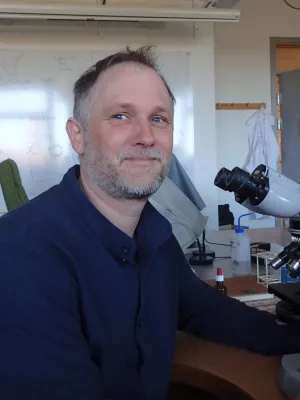
Karl Ljung
Lecturer

The effects of multiple stressors on the distribution of coastal benthic foraminifera : A case study from the Skagerrak-Baltic Sea region
Author
Summary, in English
Coastal ecosystems are subjected to both large natural variability and increasing anthropogenic impact on environmental parameters such as changes in salinity, temperature, and pH. This study documents the distribution of living benthic foraminifera under the influence of multiple environmental stressors in the Skagerrak-Baltic Sea region. Sediment core tops were studied at five sites along a transect from the Skagerrak to the Baltic Sea, with strong environmental gradients, especially in terms of salinity, pH, calcium carbonate saturation and dissolved oxygen concentration in the bottom water and pore water. We found that living foraminiferal densities and species richness were higher at the Skagerrak station, where the general living conditions were relatively beneficial for Foraminifera, with higher salinity and Ωcalc in the water column and higher pH and oxygen concentration in the bottom and pore water. The most common species reported at each station reflect the differences in the environmental conditions between the stations. The dominant species were Cassidulina laevigata and Hyalinea balthica in the Skagerrak, Stainforthia fusiformis, Nonionella aff. stella and Nonionoides turgida in the Kattegat and N. aff. stella and Nonionellina labradorica in the Öresund. The most adverse conditions, such as low salinity, low Ωcalc, low dissolved oxygen concentrations and low pH, were noted at the Baltic Sea stations, where the calcareous tests of the dominant living taxa Ammonia spp. and Elphidium spp. were partially to completely dissolved, probably due to a combination of different stressors affecting the required energy for biomineralization. Even though Foraminifera are able to live in extremely varying environmental conditions, the present results suggest that the benthic coastal ecosystems in the studied region, which are apparently affected by an increase in the range of environmental variability, will probably be even more influenced by a future increase in anthropogenic impacts, including coastal ocean acidification and deoxygenation.
Department/s
- Quaternary Sciences
- Division aquatic ecology
- Aquatic Ecology
Publishing year
2018-03-01
Language
English
Pages
42-56
Publication/Series
Marine Micropaleontology
Volume
139
Document type
Journal article
Publisher
Elsevier
Topic
- Ecology
- Environmental Sciences
Keywords
- Benthic foraminifera
- Coastal zone
- Hypoxia
- Multiple stressors
- Salinity gradient
- Skagerrak-Baltic Sea
Status
Published
Research group
- Aquatic Ecology
ISBN/ISSN/Other
- ISSN: 0377-8398

